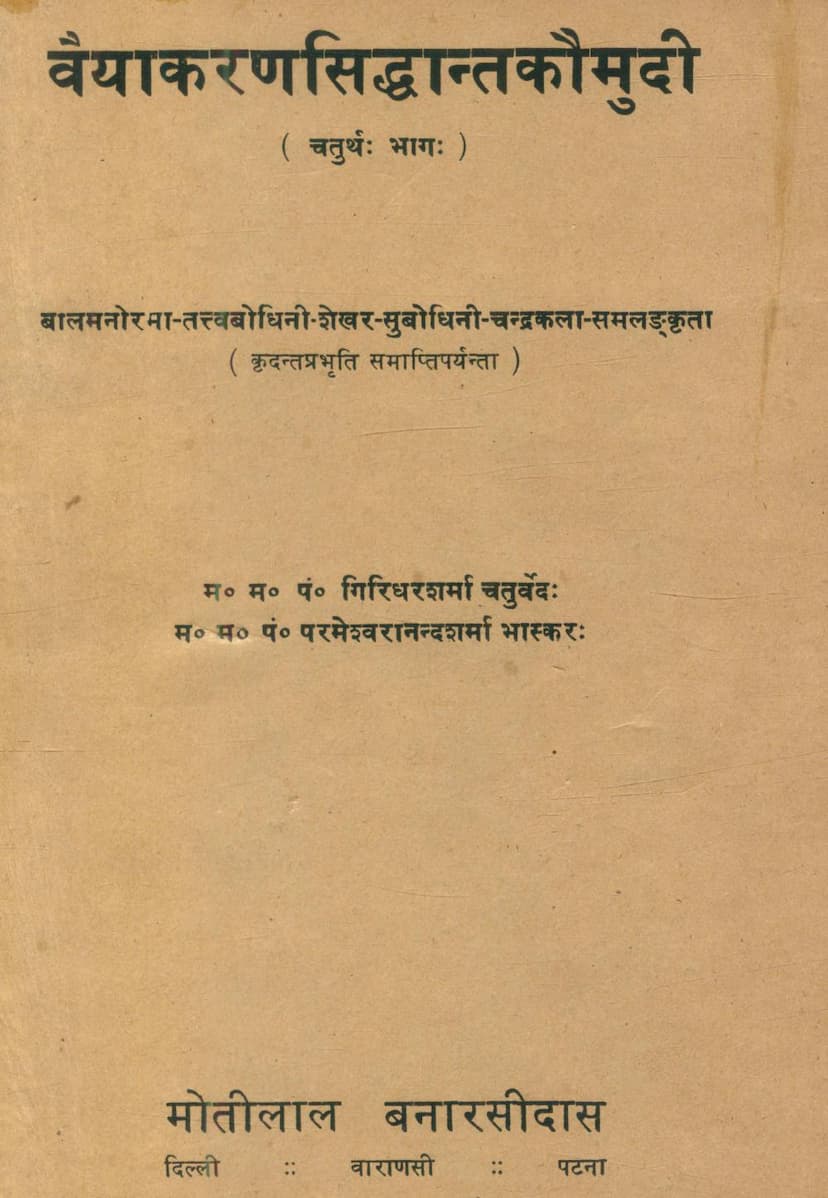Laghu Siddhant Kaumudi Part 04
Added to library: September 2, 2025

Summary
The provided text is the fourth part (part 04) of the book "Laghu Siddhant Kaumudi," authored by Girdhar Sharma and Parmeshwaranand Sharma, and published by Motilal Banarsidass Pvt Ltd. This section, like the previous parts, is a commentary on the Vaiyakarana Siddhanta Kaumudi by Bhattoji Dikshita.
Specifically, this segment covers the Kṛdanta (कृदन्त) section of the Vibhakti (विभक्ति) chapter, beginning with the Kṛtya (कृत्य) prakaraṇa (प्रकरण). It systematically explains the formation of verbal compounds (kṛdanta words) from roots, focusing on the application of various suffixes and grammatical rules as laid down in Pāṇini's Aṣṭādhyāyī.
Key concepts and rules discussed include:
- Kṛt (कृत्) and Nighna (ङ्नि) suffixes: The text elaborates on the rules for attaching these suffixes to verb roots, explaining their usage in forming noun forms derived from verbs.
- Kṛtya (कृत्य) suffixes: It delves into specific kṛtya suffixes like tavya (तव्य), anīyar (अनीयर्), and others, detailing their application in different grammatical contexts (kartṛi - agent, karmani - object, bhāve - in the sense of the action itself).
- The "vāsarūpa" (वासरूप) rule: This important rule, which allows a different suffix to be used when two suffixes are taught with the same meaning, is discussed, particularly in relation to gender and the scope of the rule.
- The "Kṛdatiṅ" (कृदतिङ्) rule: This rule defines the kṛt status of suffixes that are not tiṅ (final verb conjugations), emphasizing their importance in forming nominal stems.
- The "dhātoḥ" (धातोः) rule: The text explains how the suffix is applied after a verb root (dhātu), and the continuation of the dhātu authority throughout the third chapter.
- Specific suffix applications: Numerous sutras (aphorisms) from Pāṇini are explained with examples, detailing the formation of words like kartavya (कर्तव्य), karaṇīya (करणीय), tavya (तव्य), tavyat (तव्यत्), anīyar (अनीयर्), kta (क्त), lyuṭ (ल्युट्), kyap (क्यप्), ktvā (क्त्वा), lyap (ल्यप्), ṇamul (णमुल्), kvip (क्विप्), kvip (क्विप्), kvin (क्विन्), kvu (क्वु), ki (कि), śatṛ (श), śānas (शानच्), ktvāl (क्त्वा), and lyap (ल्यप्), among many others.
- The role of "Upasarga" (उपसर्ग - prepositions): The text frequently discusses how prepositions affect the meaning and application of rules, especially in forming compounds and determining the case of the verb.
- The scope of "Dhātu" (धातु - verb root) authority: It clarifies how the authority of the verb root extends through various rules and how it is sometimes limited or extended.
- The continuation of grammatical rules: The commentary often refers back to previously explained rules or explains how rules established in earlier chapters of the Aṣṭādhyāyī are applied here.
- The importance of grammatical convention: The authors highlight the significance of bhāṣya (commentary) and vārttika (secondary annotations) in interpreting and applying the sutras, often resolving ambiguities or apparent contradictions.
- Specific prakaraṇas within Kṛdanta: The text progresses through various sub-sections within the kṛdanta formation, covering suffixes like kta, lyuṭ, kyap, tavya, anīyar, ṇamul, kvip, kvu, ki, etc., and the specific rules governing their usage, often in the context of agentive, objective, and verbal noun formations.
The text is meticulously detailed, providing explanations of individual sutras with Sanskrit examples and referencing earlier principles. It appears to be a comprehensive guide for understanding the complex rules of Sanskrit verb morphology as codified in Pāṇini's grammar. The presence of multiple commentaries (Bālamanorama, Tattvabodhini, Śekhara, Subodhini, Candrakalā) is also noted, indicating the depth of scholarly engagement with this subject matter.
In essence, Laghu Siddhant Kaumudi Part 04 ( Uttarardha ) focuses on the detailed grammatical analysis of verb-derived words (kṛdanta) in Sanskrit, explaining the formation and usage of numerous suffixes that are crucial for understanding Sanskrit word-formation, particularly in the context of Pāṇini's grammatical system. It seems to be a standard text for advanced Sanskrit learners and grammarians.